By Amanda May
My investment in writing center social media usage and non-usage grew out of my personal and professional social media practice. I still remember going to the Southeastern Writing Center Association’s 2016 conference and meeting Molly Wright, who ran the Facebook group Writing Center Network. At the time, that was my only connection to the writing center field because I was the sole writing center employee on campus. Molly convinced me to join Twitter because of #wcchat, a biweekly professional event that writing center administrators and tutors used to discuss writing center issues. That was where I first began to notice that writing centers themselves had social media accounts. In an effort to grow my own professional network, I started following the writing centers that popped up in my Twitter feed and on my Facebook page. Then, in 2018, I started creating social media posts for Florida State University’s Reading-Writing Center.
Recently, I’ve begun to wonder how our social media usage has changed since last year, when I started a new position at an institution whose writing center does not currently use social media, and since 2018, when I first began to post social media content on behalf of Florida State University’s writing center. I hope to use this space to explore those thoughts by raising some questions, both for writing centers not using social media and for those that do. In doing so, I hope that writing centers can continue to reflect on how their own social media use or non-use has evolved in response to the COVID-19 pandemic. To begin, I consider writing centers not currently using social media, which reflects my current professional context. I then raise questions for writing centers that are engaged in social media usage currently.
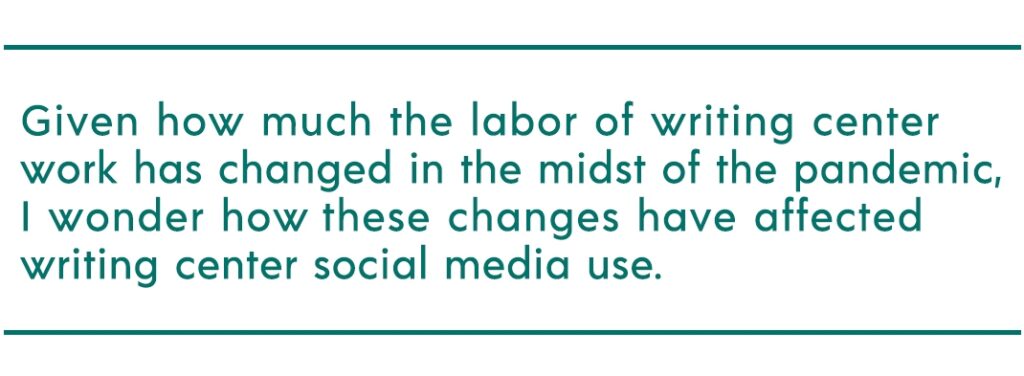
Social Media Non-Use: How Are We Staying Connected?
Social media non-usage is not widely mentioned in the existing literature about and discussions of writing center social media usage. In fact, one of the only mentions comes from Rebecca Jackson and Jackie Grutsch McKinney’s “Beyond Tutoring: Mapping the Invisible Landscape of Writing Center Work.” In their Praxis article, they present 2009 survey data that describes writing center services outside of one-to-one tutoring. One category, digital community building/social networking, includes the usage of contemporary social media tools like Facebook, MySpace, and Twitter. Of their 144 survey respondents, 52 (36.1%) used social media, meaning the remaining 92 (63.9%) did not (8). While their data has aged considerably by social media standards, it still highlights the very real probability that not all writing centers use social media. Thus, in considering how things have changed, it’s important to examine how writing centers have attempted to maintain connections during the pandemic.
At present, New Mexico Highlands University, my current institutional context, continues to operate fully online. We are also a writing center without a social media presence, but we still use technologies to network us in spaces less public than Facebook or Twitter. My efforts to create and maintain connections thus consist of biweekly meetings on Zoom (fairly informal due to the Zoom fatigue both my tutors and I are experiencing), e-mails (both for the tutors and for campus), and Group.Me. I below discuss the latter two.
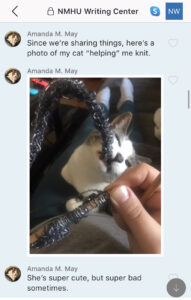
Notably, my local context is small in terms of student body, and partly because of this small size, I have been fortunate to be able to network with other departments through email. This network is notably different than those of social media: it is internal, it is more formal, and often, information flows not only directly from departments but also from individuals who mistakenly receive emails related to writing center business, typically the former interim director. In these instances, he forwards relevant emails to me so I can address the issue. As a result, I’ve formed partnerships with Student Success and marketing through requests for promotional materials. As well, I’ve formed a working relationship with an instructor who requests a workshop for her graduate course once a semester. These on-campus partnerships could emerge out of social media use, but in my current context, in the absence of a writing center social media presence, they are emerging anyway through email.
I use emails to keep in touch with tutors as well, but this semester, we are facing a unique issue: we have a smaller team spread over three time zones, with one individual running 14 hours behind Highlands’ local time zone. To transcend these international barriers, I implemented Group.Me, a communicative technology we used at Florida State University once we transitioned to fully online operations, and one that I selected precisely because it was accessible in various countries. My success with this implementation, however, has been mixed. Tutors mention that they forget to check it. And sometimes, messages about technological issues can be overwhelming given other work I’m doing. That said, it has allowed me to maintain open lines of communication with the tutor abroad and address various issues as they arise. And it has allowed us to occasionally engage in rapport-building in our online state, as this example shows.
Having studied social media use and non-use in writing centers before in multiple ways, I have seen a broad range of approaches to implementing such media. However, my examinations of writing center social media use all occurred before the pandemic shifted writing center work to primarily online spaces. As a result, I have to question how writing center social media use has changed in three respects: practices, labor, and engagement.
Social Media Use: What’s the Current State?
How have our posting practices changed?
In this instance, practices refer to aspects of social media like posting frequency, content, strategies, and similar considerations. My interest in frequency is informed by both Grutsch McKinney’s 2010 mini-study of Twitter and Mark Jacobs’s best practices, which emphasize a need to post frequently. Content, here, refers to the information and media being used in social media posts and can include, as Michael Shapiro, Jennifer Marciniak, and Jennifer Fandel’s blog posts highlight, text as well as still images like memes and photographs and the Canva graphic I have included here. Shapiro also mentions hashtags, a web affordance that allows audiences to see content centered around a theme. Strategies for posting in this case include approaches to developing social media content.
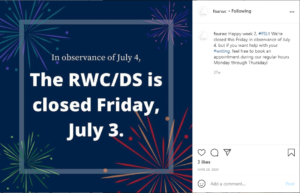
Before COVID hit, when I was posting social media content for FSU, I often used Canva to create resources, but I also included photographs of the writing center. Images tend to be faster to process, and it always felt to me like they got more engagement. But after we migrated online, I lacked enough photographs of the space to sustainably post new images. Most of the posts that went out were Canva graphics that highlighted changes in operations (a purpose McKinney highlights in “Geek in the Center” through her open-closed status code) or writing resources.
I name these particular considerations because of my own experience with writing center social media use. Regarding practices, were I still using social media for the writing center, it would be fairly easy to continue using Canva, for instance, or posting memes. Photographs of physical space, considering our online state, would be less feasible for many writing centers to use.
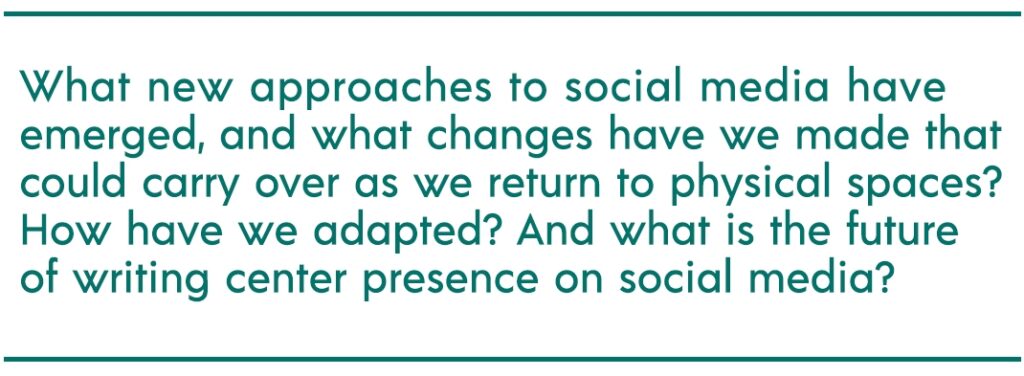
How has the labor of posting changed?
Related to the question of practice, particularly posting frequency, is the question of how the labor of posting has changed. Jacobs highlights in his blog post that while social media are free or low-cost to use, they nonetheless require resources in the form of time. Part of why I raise this question relates to the other changes I’ve seen in my teaching and administrative practices. But I also raise the question because looking back, as a graduate student teaching a course and serving as our writing center’s assistant director, when my workload increased due to other administrative duties, teaching and grading, and scholarship, the first thing I often put down was posting on the writing center’s social media because I felt—and the director agreed—that it wasn’t the most important aspect of writing center work.
I imagine that for many tutors and administrators, their work routines and priorities have shifted as a result of the pandemic. Collectively, we were, and still are, learning how to operate online. In connection to posting practices, I question whether tutors and administrators are still posting as frequently, or whether and how they have redistributed the responsibilities of posting on writing center social media accounts to accommodate our new conditions. Likewise, given how much the labor of writing center work has changed, at least for me, in the midst of the pandemic, I wonder how it has changed at other centers, and how these changes have affected writing center social media use.
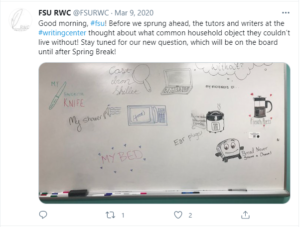
How has engagement changed?
In relation to my personal experiences with writing center work, I mention engagement because students—both those that work as writing center tutors and administrators and those that attend sessions—have had to teach themselves how to learn in online spaces as a result of the pandemic. Terms like “Zoom Fatigue” attempt to explain specific emergent issues, but given that students may already be experiencing burnout as a result of our mostly remote state, I wonder if they are even paying attention to social media accounts run by academic departments. Further, since the pandemic has created a kind of disconnect from the physical campus space, as many operations are still remote, I wonder if students are even accounting for their identities as students on social media. As a result, writing center social media engagement likely continues to be limited because the audiences we might normally reach out to may not have the headspace to pay attention.
Looking Forward: The Post-Pandemic Digital Landscape
Because the pandemic has lasted over a year, I wanted to use this space to raise questions about how the state of writing center social media use and non-use has changed. However, as we progress towards a return to on-campus operations, I hope we as a field and as individual writing centers can reflect on what the pandemic has taught us about our work, both in relation to social media and more broadly. What new approaches to social media have emerged, for instance, and what changes have we made that could carry over as we return to physical spaces? How have we adapted? And what is the future of writing center presence on social media? I suspect the choice is greatly shaped, as a lot of writing center work is, by our individual institutional contexts. Nonetheless, the questions I have raised here can help us reflect on the changes in our outreach and collaboration, values that have continued to be at the center of our practice even as our working environments have changed.
The header image in this blog post is from Today Testing and is used under a Creative Commons Attribution-Share Alike 4.0 International license.
Works Cited
Fandel, Jennifer. “Conversation Starter: Social Media and the Writing Center.” Another Word: From the Writing Center at the University of Wisconsin–Madison, 12 Dec. 2018,. Accessed 13 June 2019.
Grutsch McKinney, Jackie. “Geek in the Center: Twitter.” WLN: A Journal of Writing Center Scholarship, vol. 34, no. 4-5, 2010, pp. 6–10.
Jackson, Rebecca, and Jackie Grutsch McKinney. “Beyond Tutoring: Mapping the Invisible Landscape of Writing Center Work.” Praxis: A Journal of Writing Center Scholarship, vol. 9, no. 1, 2009, 1–12.
Marciniak, Jenifer. “Writing Centers and twitter: How We Use This ‘Weird’ Space and How Students Perceive It.” UofL Writing Center, Sept. 19, 2012,.
Shapiro, Mike. “The Social Center: Why Writing Centers Need Twitter.” Another Word: From the Writing Center of the University of Wisconsin–Madison, May 6, 2013,.
 Amanda M. May currently serves as an assistant professor of English and director of the writing center at New Mexico Highlands University. Her writing center experience includes working as an undergraduate writing tutor, a graduate writing tutor and later administrator, and a writing center administrator and spans over a decade. She received her PhD from Florida State University in 2020, where she studied English with a specialization in rhetoric and composition, taught various English courses, and served the Reading-Writing Center and Digital Studio as tutor/consultant, undergraduate tutor mentor, and assistant director.
Amanda M. May currently serves as an assistant professor of English and director of the writing center at New Mexico Highlands University. Her writing center experience includes working as an undergraduate writing tutor, a graduate writing tutor and later administrator, and a writing center administrator and spans over a decade. She received her PhD from Florida State University in 2020, where she studied English with a specialization in rhetoric and composition, taught various English courses, and served the Reading-Writing Center and Digital Studio as tutor/consultant, undergraduate tutor mentor, and assistant director.


Thank you for the tips! Networking has been hard since COVID started.
This was a really difficult period of time for all of us and social media helped us a lot to stay connected and safe!
Hi Amanda,
It’s interesting to know your writing story and how you have learned and handled the social media accounts for Florida State University. During the COVID-19 pandemic, we also use the Zoom platform to get connected. Overall I enjoyed reading your story that makes us understand the importance of networking.
Thank you for taking out time to write a post for us.
These are some great suggestions. I think that networking was so much easier before the pandemic so now I proves to a challenge. I think that social media, forums and meetup groups have helped a bunch. But always looking for ways to connect and network.